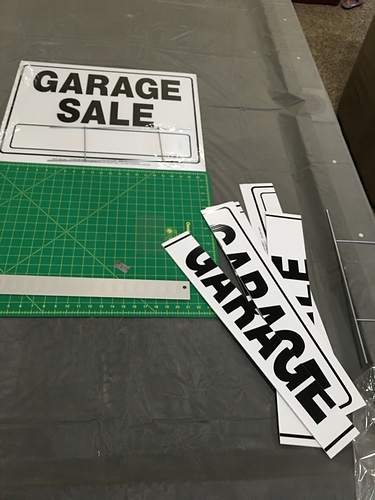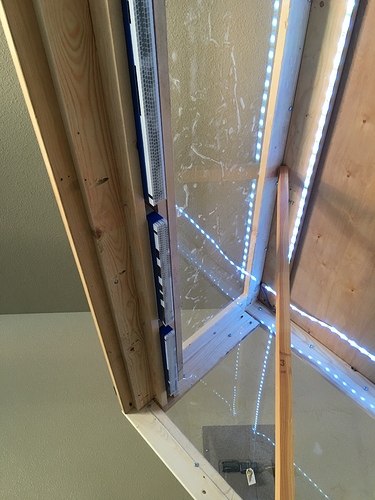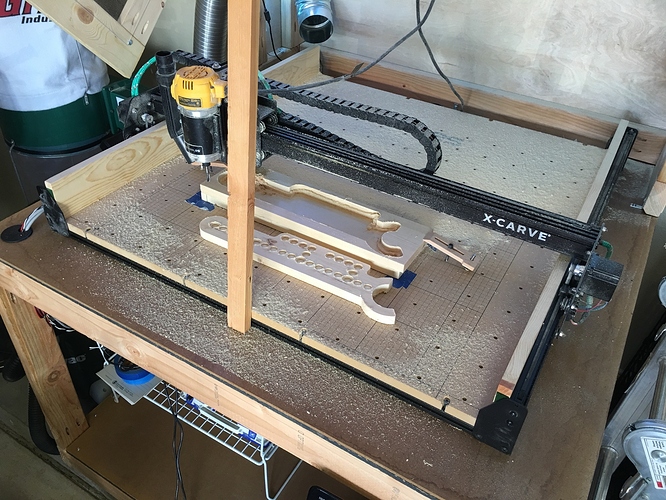I’m planning on putting the dust collector connection on the rear of the box (on one side, so I can keep the enclosure up against the wall).
I’m planning on putting a series of holes (with flow-straightening tubes) along the front of the enclosure above the height of the waste board to generate a more uniform “sheet” of air flowing toward the back of the machine over the work surface. I’ll probably use 1/2" PVC or something similar, cut into ~4" lengths and glued together in a row, unless I can find some kind of hollow filter media or something else with inner channels I can use to straighten airflow the same way.
That’s a fine idea… I hadn’t considered that. Cut in half, they’d be about the right length so as not to interfere with the machine. I’ll see what diameter I can find in bulk for a good price, then I’ll do some math to figure out how many I’ll need to allow enough flow. Fantastic. 
I suppose I could build a simple frame to arrange the straw bundle(s) into.
Also, that was the term/mechanic I couldn’t think of… “laminar flow”. Thank you. 
Do you really want laminar flow? I’d think for both dust removal and cooling that turbulent flow would be better, but I’m not that kind of engineer.
Turbulent flow could kick sawdust up into the vwheels belts off the side any open spaces that may not be in direct line with the exit… Laminar will do a more clean flow like a wind tunnel you want as little resistance to the exit as you can to keep the dust on the way out and not settle on components - in theory at least. I do not know enough about it to really explain it good.
I agree with that, but in many ways the predictable nature of laminar flow is also why I worry it wouldn’t work. Boundary layers form in laminar flow, so I’d think that any dust that settles onto a surface wouldn’t get picked up. Likewise it seems like you’d be likely to get several spots that the airflow just moves around (and therefore dust collects).
I’m not sure of myself by any means, but thought I’d bring it up. Its a cool idea, nonetheless!
These are all excellent points, and I love the ideas!
I’m planning on taking standard drinking straws (roughly 8" long each), cutting them in half to make lengths of about 4" each, then bundling them together in a frame that runs the width of the front of the table… 32-34" wide frame… with the height of the frame dictated by how many straws I have/need to allow flow into the table roughly the same capacity of flow out of the table.
My primary goal is to move the really fine dust to the back of the machine before it settles… that’s what gets out into the atmosphere and sticks to the belts and wheels. If I can successfully get that material moved to the back and sucked out, I consider it a 100% success. I’ll vacuum up the bigger stuff as needed… but that really fine stuff seems to be the real problem I want to solve with this solution.
I will document my progress and outcome. Stay tuned! 
I saw one enclosure that had the locline ( or similar) pointed at the bit. These then fed up via flexible hoses to the roof of the enclosure. Then a standard vacuum port at the back. Basically, the air inlet to the enclosure was the locline, giving a blast of air at the cutting bit to be blown up and towards the back.
That gives me an idea of putting this type of inlet from the outside, pointed across the tool and toward the back of the machine to give the chips and dust a rearward “push”… not a bad idea. 
Maybe, even just another iteration of my custom 3D printed router boot to direct the router’s circulating air blast rearward… all the ideas! 
Okay… successful test, this weekend.
I got the following accomplished…
- setup new 1HP dust collector (from Amazon for under $200
- plumbed 4" hose and elbows to direct flow out of enclosure
- modified front of enclosure to include “laminar flow assembly” made from chopped up corrugated vinyl “garage sale” signs (4" wide strips stacked across the front just above wasteboard height)
- first test piece cut with new system
- observed that fine dust was captured, larger chips were moved toward back of enclosure, Y belts stayed clear, and it ran at a reasonable volume having the desired effect
Here’s a link to my YouTube video showing the system in action…
Video of machine in action
Here are some photos showing the setup, configuration, and the outcome of using the system (feel free to ask, if you would like more specific details on any of this)…
Nice - I am going to try some 3/4" pvc hopefully the air flow isn’t going to be too great, I just happen to have some on hand I am going to make a fixed panel I can swap out if it does not work.
I’ve been following some of these posts on enclosures for the X-Carve, not exactly studying them closely because I’m not interested in building anything like that, but my question is, are these enclosures being built to quiet machining operations or for dust control. Because they seem to fail miserably at both.
PWAC, be sure to post back and let us know how the 3/4" PVC solution works for you. I was thinking of going that route, and it was a coin toss. With your results, we’ll have a better picture of varying solutions. 
JeffParish, even though you stated you’ve not studied the enclosures and aren’t interested in building one, I’m happy to explain the thinking behind putting one of these machines inside an enclosure.
Yes, the the enclosure helps with dust control (cleanliness) and noise control (dampening). No reasonable person expects these machines to run silently. That’s not realistic. Also, nobody expects them to run in a manner where they remain sterile and completely dust free during/after operating.
First, running the small, stock tool driver motor doesn’t generate the same noise that running the larger, faster, and louder Dewalt router tool driver. The router’s motor produces a natural high-pitched whine when running. It also produces more noise when working against the material. When you combine these characteristics, it makes for a very noisy experience. The enclosure cuts the high-pitched whine down, and also knocks the working noise down. Running with the enclosure open/off is a great deal louder. The difference is being able to have a conversation next to the machine versus not being able to. I apologize that the audio in my YouTube videos can’t adequately reflect this, but the difference is clear.
Second, running the small, stock driver motor doesn’t generate the same mess that running the larger, faster Dewalt router tool driver. The router runs at a much higher tool speed, and it cuts material faster than the stock driver (feed and speed)… thus, the chips and dust are flung further from the machine and vary in size from chips down to baby-powder-fine dust. Also, the router moves a high volume of air through its motor to both cool it and to blow chips/dust away from the tool. This scatters chips and blows them all over the place. The enclosure keeps the dust and chips from flying all over the room, literally.
It is obvious the dust collector attached to the enclosure generates its own noise, but it serves multiple purposes. Without adequate dust collection, I found that a plume of “smoke-like” wood powder would rise out of the enclosure after an operation. This dust would settle all over the room. I wanted to collect this material to keep it contained. Also, with my setup, the dust collector helps generate the incoming flow over the work surface to keep the Y belts clear from dust/chips, and it also collects the really fine dust in the bag. Between operations, simple vacuuming or brushing clears the work space for the next operation.
The bottom line is that I’ve found through trial and error that this enclosure and dust collector is the current optimal solution for me, and I’ve shared my process and experience with the group. Whether it’s right for everyone’s situation and preference isn’t for me to decide.
I hope this fills in the blanks you might have had regarding my setup.
Totally understand what you’re trying to accomplish and also the theory behind your thinking and design. I also use the Dewalt and have many hours on my machine, but I never have that much dust/chips after a carve . Sure, it’s in the cabinet but still all over. With a good dust collector shoe/boot, and there are many examples in the forum, you will end up with next to zero dust anywhere. I can cut for hours and collect the leftover chips on one finger tip. I can see the reduction of noise with the enclosure and that maybe a redeeming factor, but you definitely could use a better dust control system. Check out the dust shoe designs in the forum and see if one will work for you. You’ll be glad you did.
Wow… that is impressive. What’s driving the dust shoe? Is it using a shop-vac or a dust collector?
I tried a couple of different shoes/guards with my shop-vac, and didn’t have much luck. One of the post promising designs I’ve seen on here was one that was like a loop around the tool that hooked to a shop-vac, but it didn’t move up and down on the Z-axis… so I’d have to keep it very close to the work to make it function.
Do you have a specific version/design I should look at? I’d like to give it a try… I’m always looking on how to improve. Nothing says I can’t run flexible 4" hose over to the router and collect closer to or right at the source of the mess.
This is a post showing my design, and still the one I use. It has gone through different phases but I like it for it’s simplicity and effectiveness. There are many good designs out there, so check them out and decide which may work for you.
That’s pretty rad. I’m thinking of moving the inlet to my Dust Collector (via flex hose) to the carriage. If I can design a wide air scoop that I can mount to the carriage right behind the working area, I can definitely capture more of the dust/chips… and run more cleanly. I guess I need to start taking some measurements and see where it leads me.
Hey Everyone,
I build an enclosure make my shop quieter and save the X-carve and the Shop from dust.
Iam still working on a dust suck, but i dont want to load more weight on the x-axis, and make another noise source.
The enclosure is Made of 8 mm plywood and 20 mm Sound insulation mats.
If have 2 plexiglas Windows.
It works very well, I Can speak with normal Volumen in the Shop, and work on sunday,without disturb my neighbors.
Did you use ant type of switch to stop the router if door opened?
I did not… I often run with the door open.
Cristoph, your enclosure looks great, be great to see a vid to see how your enclosure compares to Cory’s in respect of noise absorption. I would love an X Carve the only thing that is putting me off is the noise factor, I know that you all say that you can manage to have a conversation while it is running but the noise levels in Cory’s vid are just unacceptable for me due to my neighbours 
Does anyone think it would be in anyway possible to reduce the noise produced by the X-Carve to levels that could be contained within an average sized room or should I re-manage my expectations in this respect?









